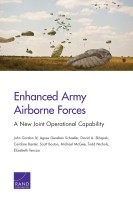| 来源类型 | Research Reports
|
| 规范类型 | 报告
|
| ISBN | 9780833082169
|
| 来源ID | RR-309-A
|
| Enhanced Army Airborne Forces: A New Joint Operational Capability |
| John Gordon IV; Agnes Gereben Schaefer; David A. Shlapak; Caroline Baxter; Scott Boston; Michael McGee; Todd Nichols; Elizabeth Tencza
|
| 发表日期 | 2014
|
| 出版年 | 2014
|
| 页码 | 132
|
| 语种 | 英语
|
| 结论 |
U.S. Army Airborne Forces Could Play a Pivotal Role in Key Missions in the Future, Particularly Against Hybrid Threats and in Anti-Access Environments, but Could Face New Threats- Army airborne forces are unique in their ability to deploy quickly from the continental United States via U.S. Air Force transport aircraft, including to locations deep inland and beyond the reach of maritime forces operating in littoral regions.
- Airborne forces will likely face increasingly sophisticated anti-access threats and will require increased options for quickly and safely delivering personnel and equipment to these challenging areas of operations.
A Light Armored Infantry Capability That Can be Airdropped by Parachute or Air-Landed at an Airfield Would Provide Airborne Forces with Increased Speed, Mobility, Survivability, and Firepower- Specifically, such a capability could support missions to counter anti-access/area denial in hybrid environments, counter or secure weapons of mass destruction, counter terrorism or insurgencies, conduct noncombatant evacuation operations with support from air assets, conduct complex humanitarian assistance and disaster relief operations, rapidly establish an enclave (e.g., to prevent genocide), and rapidly interpose a peacekeeping force in a time-sensitive situation. Enhanced airborne capabilities could also offer decisionmakers better options to stabilize potential conflicts more quickly and prevent them from escalating.
- Although airborne forces currently conduct many of these operations, enhancements to the force would greatly expand that ability.
- Given the Army's near-term requirements and the need to consider extant equipment, the Light Armored Vehicle, second generation (LAV-II), family of vehicles appears to be the most promising candidate platform for enabling an airborne force to achieve its objectives.
|
| 摘要 |
- The Army should refine the operational concepts associated with a new airborne light armored infantry capability, including how it will be employed and what key joint enablers will be needed.
- The Army should conduct an experimentation program before deploying this new capability on a large scale.
- The Army should examine other vehicle options beyond the one provisionally identified as the preferred candidate for this concept (the LAV-II), including the Stryker and vehicles currently in use in foreign militaries.
- The Army should determine the Air Force's main constraints to operationalize some portion of this concept. For example, it might be helpful if more C-17 crews were airdrop-capable than is the case today. Because the Air Force transport fleet is important to the entire joint force, the Army and Air Force would need to discuss what is possible under the desired timelines and scale.
- The Army should identify additional rigging and other administrative requirements. In some cases, new rigging capacity and other infrastructure might need to be needed to accommodate light armored vehicles in the LAV-II or Stryker class.
- The Army should establish the costs for the various vehicle options it is considering, as well as for any associated new units that would be required.
- The Army should decide on an initial organizational construct for any new airborne capability. For instance, does it want to convert one or more brigades to this configuration or just a single battalion?
|
| 主题 | Armored Vehicles
; Military Aircraft
; Military Airlift
; Military Force Planning
; Military Logistics
; United States Army
; Wargaming
|
| URL | https://www.rand.org/pubs/research_reports/RR309.html
|
| 来源智库 | RAND Corporation (United States)
|
| 资源类型 | 智库出版物
|
| 条目标识符 | http://119.78.100.153/handle/2XGU8XDN/107690
|
推荐引用方式
GB/T 7714 |
John Gordon IV,Agnes Gereben Schaefer,David A. Shlapak,et al. Enhanced Army Airborne Forces: A New Joint Operational Capability. 2014.
|
|
文件名:
|
x1495315143576.jpg
|
|
格式:
|
JPEG
|

|
文件名:
|
RAND_RR309.pdf
|
|
格式:
|
Adobe PDF
|
除非特别说明,本系统中所有内容都受版权保护,并保留所有权利。